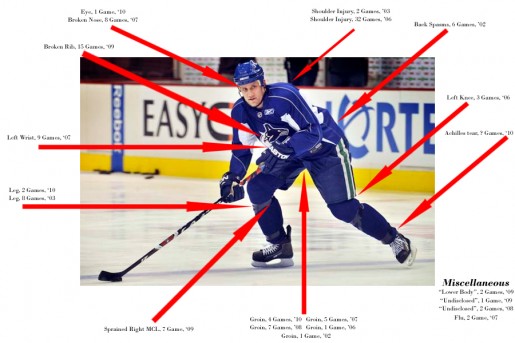Women In Hockey Series
Part 1: Sign Of The Times
Part 2: Heading To The Quiet Room

There are just few words to describe the injuries that can sometimes often happen in just one player’s career. Today we delve into The Quiet Room and talk to Jo Innes. Jo is quite the expert on injuries and believe me, she has some injuries that will test the mettle of your stomach. Are you ready for a good old fashioned stomach churning “Q&A”? Let’s get into the carnage!
====================================================
And Now The Questions…..
1. First off, would you kindly tell us a little bit about yourself?
I was born and raised in Ottawa, and through a long, boring, circuitous route largely made of questionable life choices I ended up in the southeast US working as a paramedic for several years. A series of less questionable choices led me to medical school, and then to emergency medicine.
2. How did you get into the injury business as it relates to hockey players?
I’ve always loved hockey, and sports medicine has always fascinated me. Twitter started out as a way to avoid studying in med school, and my timeline quickly evolved into primarily hockey people. I remember scrolling though and constantly getting irritated at people tweeting completely wrong info about various injuries. I started off tweeting my rants, and a friend suggested I start a blog. That blog caught Justin Bourne’s eye when he was putting together Backhand Shelf for The Score, and here we are.
3. What are your thoughts so far on the amount of injuries this year?
I can’t decide if we’re truly seeing more injuries this year or not. People have floated theories about a lack of conditioning or shortened training camps resulting in more, but I’m not convinced. It’s rare that you see a truly conditioning-related injury in hockey. Concussions, lacerations, and broken bones have nothing to do with conditioning. Sprains and strains make a stronger case, but I’m waiting for one of the stats geniuses to come up with some metric that measures time lost to conditioning-related injuries. I think they should call it the Innes.
4. What is the worst “mouth” injury you have ever seen? How many tetanus shots were needed?
Mouth injuries are always bad. I’ve seen people whose knocked-out teeth were embedded in their lips, gums lacerated right off the bone, broken jaws where the bone was poking through their face, full-thickness tongue lacerations, and just about every other conceivable way of screwing up your mouth. The highlights are always the drunks who stumble in with their teeth in hand asking if you can put them back in (sometimes the answer is yes). Everybody only gets one tetanus shot, but they hurt like stink.
5. There is always that bizarre injury that makes one go HOW? Is there one that just made you just wonder?
The really bizarre dislocations always get me. Dislocated kneecaps are fairly common, and usually they just sort of slide laterally out of place (to the outside of the knee joint). I had a patient whose patella was in the right location, but flipped up onto its side. The guy somehow did it while he was dancing at a club. I so badly wish I’d seen exactly what kind of freaky dance could do that. My other favourite was a kid who dislocated his shoulder at hockey. Instead of a nice normal dislocation where they just sort of hold their arm against their body and quietly whimper until it’s back in place, this kid had his arm raised up over his head and couldn’t move it any other way. That’s a treat in the back of an ambulance for a 30-minute transport.
6. Is there something you want to tell hockey fans about injuries they may not know?
I wish there was a way to impress on people how serious head injuries are. I know pro-fighting fans are sick of hearing it, but it’s becoming more and more clear that a career spent getting punched in the head results in permanent changes to the brain. Hockey without fighting can still be very entertaining, and we won’t be dooming guys to early dementia.
7. What can we expect next from The Quiet Room?
I’ll keep following regular-season injuries like always, and I’ve just started a series on the NHL’s biggest dirtbags based on a piece Down Goes Brown did for Grantland. What I’m hoping for in the future is a look at what kind of medical magic happens at the arena during games. This is mostly because I need an excuse to stare in complete fangirl admiration at the docs that can suture massive facial lacerations in the amount of time it takes for a commercial break to happen.
8. Lastly, will there ever be a real “Quiet Room” in the NHL? Why or Why not?
I hope so. Things have come a long way since the NHL instituted the new guidelines requiring physician evaluation of anyone showing signs or symptoms of a concussion. We’re seeing guys getting pulled more often, and kept out longer. The problem is it’s still inconsistent, and that’s evident when you see things like Gabriel Landeskog getting evaluated then coming back out to play another period before going out with a concussion, or Sergei Bobrovskiy getting smelling salts and no evaluation at all. The American Academy of Neurology just released a new position statement saying that any athlete suspected of concussion should immediately be removed from play. I hope the NHL seriously considers integrating that into their guidelines. You’re better off losing someone unnecessarily for one game instead of for weeks, months, or the rest of their career.
================================================
What will come next in Part Three in our Women In Hockey series? Stay tuned!